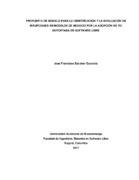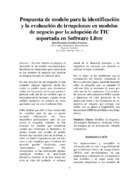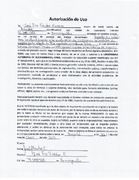Mostrar el registro sencillo del ítem
Propuesta de modelo para la identificación y la evaluación de irrupciones en modelos de negocio por la adopción de TIC soportada en software libre
| dc.contributor.advisor | Parra Valencia, Jorge Andrick | spa |
| dc.contributor.author | Escobar Escorcia, José Francisco | spa |
| dc.date.accessioned | 2020-06-26T21:34:41Z | |
| dc.date.available | 2020-06-26T21:34:41Z | |
| dc.date.issued | 2017-01-28 | |
| dc.identifier.uri | http://hdl.handle.net/20.500.12749/3413 | |
| dc.description.abstract | En este documento se propone el desarrollo de un modelo conceptual para identificar las irrupciones que se presentan en los modelos de negocio que adoptan tecnologías basadas en software libre. En este proyecto de investigación se han evaluado algunas hipótesis desde las cuales se pueden partir para determinar cuáles son los puntos claves que ayudan a predecir cada una de las variables que se mencionan en la literatura, a partir de un análisis cualitativo de estudios de casos que tienen que ver con el software libre. Cabe resaltar que sólo se han conservado las variables para las que se puede recopilar información con datos disponibles públicamente antes de que ocurra la irrupción. Además, se han aclarado los detalles que establecen cuando una tecnología es disruptiva. Al mismo tiempo este estudio ha podido abordar una cuestión clave en el debate, a saber, en donde los productos que son más caros y más complejos que el estándar del mercado pueden clasificarse como "innovaciones disruptivas". Por consiguiente, se han identificado algunas estrategias distintas de innovación disruptiva, basadas en la fase actual del ciclo de vida del producto, el enfoque actual de la demanda principal y los segmentos de mercado que primero se enfocan al llegar al mercado. Por lo tanto, se ha establecido que la construcción del modelo conceptual se lleve a cabo por etapas, haciendo hincapié sobre la adopción que va tomando el software libre al momento de pasar por cada uno de los cuadrantes. Los estudios de casos de varios proyectos FOSS ayudan a demostrar el valor potencial de la predicción frente a las irrupciones en los modelos de negocio que trabajan con CRM, este se aplicó a SugarCRM, una herramienta CRM desarrollada con código abierto. | spa |
| dc.description.sponsorship | Universitat Oberta de Catalunya UOC | spa |
| dc.description.tableofcontents | INTRODUCCIÓN 1 1. PLANTEAMIENTO DEL PROBLEMA 3 1.1 ANTECEDENTES 3 1.2 DESCRIPCIÓN Y FORMULACION DEL PROBLEMA 4 1.3 JUSTIFICACION 7 1.4 OBJETIVOS DE LA INVESTIGACIÓN 8 1.4.1 OBJETIVO GENERAL 8 1.4.2 OBJETIVOS ESPECÍFICOS 9 1.5 ALCANCES Y LIMITACIONES DEL PROYECTO 9 1.5.1 ALCANCES 9 1.5.2 LIMITACIONES 9 2. MARCO TEORICO 10 2.1 CARACTERÍSTICAS 11 2.2 ELEMENTOS 11 2.3 METODOLOGÍA DE LA TECNOLOGÍA DISRUPTIVA 12 2.4 PROCESOS DE LA TECNOLOGÍA DISRUPTIVA 13 2.5 MODELO DE NEGOCIO 13 2.6 HERRAMIENTAS PARA UN MODELO DE NEGOCIO 14 2.7 VENTAJAS 14 2.8 PRESENTE Y FUTURO DE LA TECNOLOGÍA DISRUPTIVA 15 2.9 MODELOS DE NEGOCIO QUE ADOPTAN LAS TECNOLOGÍAS DISRUPTIVAS 16 2.10 SOFTWARE LIBRE 16 2.11 EL SOFTWARE LIBRE ADOPTA UN MODELO DINÁMICO Y DE DISRUPCIÓN 17 3. METODO DE LA INVESTIGACION 18 3.1 DESCRIPCIÓN DEL MÉTODO 18 3.2 TIPO DE INVESTIGACIÓN 18 3.3 NIVEL DE LA INVESTIGACIÓN 19 3.4 TÉCNICAS DE INVESTIGACIÓN 19 3.5 PROCEDIMIENTO DE LA INVESTIGACIÓN 20 3.6 ESTRUCTURA DEL DESARROLLO PARA EL MODELO CONCEPTUAL 21 4. RESULTADOS DE LA INVESTIGACIÓN 22 4.1 MODELO DE NEGOCIO E HIPOTESIS 22 4.1.1 ORIENTACIÓN AL CLIENTE Y APARICIÓN DE NICHOS DE MERCADO DISRUPTORES 22 4.1.2 LAS PRINCIPALES BARRERAS DE ENTRADA EN EL MERCADO Y LA APARICIÓN DE NICHOS DE MERCADO DISRUPTORES 24 4.1.3 IRRUPCIÓN DEL MERCADO GENERAL 25 4.2 INNOVACIÓN Y TECNOLOGÍA EN ADOPCIÓN 26 4.3 LA PRODUCCIÓN DE CÓDIGO ABIERTO 29 4.4 IRRUPCIONES DEL SOFTWARE LIBRE 36 4.5 PREDICCIÓN – SOFTWARE LIBRE Y ESTUDIO DE CASOS 39 4.6 EL SERVIDOR WEB APACHE 40 4.7 ECLIPSE 42 4.8 BASE DE DATOS RELACIONAL MYSQL 43 4.9 OPEN OFFICE 45 4.10 RESUMEN DE LOS ESTUDIOS DE CASOS 47 4.11 PREDICCIÓN - CRM Y LA AMENAZA DE IRRUPCION DEL SOFTWARE LIBRE 50 4.12 LAS BARRERAS A LA ADOPTABILIDAD DE LA COMUNIDAD 54 4.13 MECANISMOS PARA MEJORAR ETAPAS 55 4.14 LA PREDICCIÓN DE DISRUPCION POR EL SOFTWARE LIBRE 56 4.15 IMPLICACIONES PARA LA TEORÍA Y PRÁCTICA 58 5. DISCUSION 60 6. CONCLUSIONES 62 7. RECOMENDACIONES Y TRABAJOS FUTUROS 66 8. REFERENCIAS BIBLIOGRAFICAS 67 | spa |
| dc.format.mimetype | application/pdf | spa |
| dc.language.iso | spa | spa |
| dc.rights.uri | http://creativecommons.org/licenses/by-nc-nd/2.5/co/ | * |
| dc.title | Propuesta de modelo para la identificación y la evaluación de irrupciones en modelos de negocio por la adopción de TIC soportada en software libre | spa |
| dc.title.translated | Proposal for a model for the identification and evaluation of disruptions in business models due to the adoption of ICT supported by free software | eng |
| dc.degree.name | Magíster en Software Libre | spa |
| dc.coverage | Bucaramanga (Colombia) | spa |
| dc.publisher.grantor | Universidad Autónoma de Bucaramanga UNAB | spa |
| dc.rights.local | Abierto (Texto Completo) | spa |
| dc.publisher.faculty | Facultad Ingeniería | spa |
| dc.publisher.program | Maestría en Software Libre | spa |
| dc.description.degreelevel | Maestría | spa |
| dc.type.driver | info:eu-repo/semantics/masterThesis | |
| dc.type.local | Tesis | spa |
| dc.type.coar | http://purl.org/coar/resource_type/c_bdcc | |
| dc.subject.keywords | Systems Engineering | eng |
| dc.subject.keywords | Free software | eng |
| dc.subject.keywords | Information systems | eng |
| dc.subject.keywords | Administration | eng |
| dc.subject.keywords | Investigations | eng |
| dc.subject.keywords | Analysis | eng |
| dc.subject.keywords | Business models | eng |
| dc.subject.keywords | Disruptive technologies | eng |
| dc.subject.keywords | Conceptual model | eng |
| dc.identifier.instname | instname:Universidad Autónoma de Bucaramanga - UNAB | spa |
| dc.identifier.reponame | reponame:Repositorio Institucional UNAB | spa |
| dc.type.hasversion | info:eu-repo/semantics/acceptedVersion | |
| dc.rights.accessrights | info:eu-repo/semantics/openAccess | spa |
| dc.rights.accessrights | http://purl.org/coar/access_right/c_abf2 | spa |
| dc.relation.references | Escobar Escorcia, José Francisco (2017). Propuesta de modelo para la identificación y la evaluación de irrupciones en modelos de negocio por la adopción de tic soportada en software libre. Bucaramanga (Santander, Colombia) : Universidad Autónoma de Bucaramanga UNAB, Universitat Oberta de Catalunya UOC | spa |
| dc.relation.references | Adaba, G., Rusu, L., & El-Mekawy, M. (2010). Organizational, Business, and Technological Aspects of the Knowledge Society. (M. D. Lytras, P. Ordonez de Pablos, A. Ziderman, A. Roulstone, H. Maurer, & J. B. Imber, Eds.) Communications in Computer and Information Science (Vol. 112). Berlin, Heidelberg: Springer Berlin Heidelberg. | spa |
| dc.relation.references | Afuah, A. (2014). Business Model Innovation. Business Model Innovation: Concepts, Analysis, and Cases. Routledge. | spa |
| dc.relation.references | Best, M., Deng, J., Stobart, R., & Marco, J. (2008). Towards an open source model for engine control systems. | spa |
| dc.relation.references | Chen, C., Zhang, J., & Guo, R.-S. (2015). The D-Day, V-Day, and bleak days of a disruptive technology: A new model for ex-ante evaluation of the timing of technology disruption. European Journal of Operational Research, 251(2), 562–574. | spa |
| dc.relation.references | Christensen, C. M. (1997). The innovator's dilemma: When new technologies cause great firms to fail. Boston, MA: Harvard Business School Press. | spa |
| dc.relation.references | Christensen, C. M. (2006). The Ongoing Process of Building a Theory of Disruption. Journal of Product Innovation Management, 23(1), 39–55. | spa |
| dc.relation.references | Cuenca, L., Boza, A., Ortiz, A., & Trienekens, J. J. M. (2014). Business-IT alignment and service oriented architecture: A proposal of a service-oriented strategic alignment model. In ICEIS 2014 - Proceedings of the 16th International Conference on Enterprise Information Systems (Vol. 3, pp. 490–495). | spa |
| dc.relation.references | Danneels, E. (2004). Disruptive Technology Reconsidered: A Critique and Research Agenda. Journal of Product Innovation Management, 21(4), 246–258. | spa |
| dc.relation.references | Echterfeld, J., Amshoff, B., & Gausemeier, J. (2015). How to use business model patterns for exploiting disruptive technologies. In IAMOT 2015 - 24th International Association for Management of Technology Conference: Technology, Innovation and Management for Sustainable Growth, Proceedings (pp. 2294–2313). Graduate School of Technology Management, University of Pretoria. | spa |
| dc.relation.references | Esteve, J., & Boldrito, R. (2010). Administración de sistemas GNU/Linux. Barcelona: Eureca Media, SL. | spa |
| dc.relation.references | Fitzgerald, B. (2006). The transformation of open source software. MIS Quarterly: Management Information Systems, 30(3), 587–598. | spa |
| dc.relation.references | Flavin, M. (2013). Disruptive conduct: the impact of disruptive technologies on social relations in higher education. Innovations in Education and Teaching International, 53(1), 3–15. | spa |
| dc.relation.references | Garrety, K., McLoughlin, I., & Zelle, G. (2013). Disruptive Innovation in Health Care: Business Models, Moral Orders and Electronic Records. Social Policy and Society, 13(04), 579–592. | spa |
| dc.relation.references | Habtay, S. R., & Holmén, M. (2014). Incumbents’ responses to disruptive business model innovation: the moderating role of technology vs. market-driven innovation. International Journal of Entrepreneurship and Innovation Management, 18(4), 289. | spa |
| dc.relation.references | KUMAGAI, K., ARAKI, M., & ONO, T. (2016). Business Process Modeling Method with Hierarchical Business Variation Analysis. Electronics and Communications in Japan, 99(2), 45–54. | spa |
| dc.relation.references | Lombardi, R., Del Giudice, M., Caputo, A., Evangelista, F., & Russo, G. (2015). Governance and assessment insights in Information Technology: The Val IT Model. Journal of the Knowledge Economy, 7(1), 1–17. | spa |
| dc.relation.references | Markides, C. (2006). Disruptive Innovation: In Need of Better Theory. Journal of Product Innovation Management, 23(1), 19–25. | spa |
| dc.relation.references | Mejia, J., Muñoz, E., & Muñoz, M. (2015). Reinforcing the applicability of multi-model environments for software process improvement using knowledge management. Science of Computer Programming, 121, 3–15. | spa |
| dc.relation.references | Politécnica, C., & Innovación, D. (2009). Innovación en Modelos de Negocio. ¿La única salida? | spa |
| dc.relation.references | Tellis, G. J. (2006). Disruptive Technology or Visionary Leadership?. Journal of Product Innovation Management, 23(1), 34–38. | spa |
| dc.contributor.cvlac | https://scienti.minciencias.gov.co/cvlac/visualizador/generarCurriculoCv.do?cod_rh=0000160326 | * |
| dc.contributor.googlescholar | https://scholar.google.es/citations?hl=es#user=O7IQH-AAAAAJ | * |
| dc.contributor.orcid | https://orcid.org/0000-0002-2060-6419 | * |
| dc.contributor.scopus | https://www.scopus.com/authid/detail.uri?authorId=57194112517 | * |
| dc.contributor.researchgate | https://www.researchgate.net/profile/Jorge_Parra_Valencia | * |
| dc.subject.lemb | Ingeniería de sistemas | spa |
| dc.subject.lemb | Software libre | spa |
| dc.subject.lemb | Sistemas de información | spa |
| dc.subject.lemb | Administración | spa |
| dc.subject.lemb | Investigaciones | spa |
| dc.subject.lemb | Análisis | spa |
| dc.description.abstractenglish | This paper proposes the development of a conceptual model to identify the intrusions that occur in business models that adopt technologies based on free software. In this research project we have evaluated some hypotheses from which to determine the key points that help predict each of the variables mentioned in the literature, based on a qualitative analysis of case studies that Have to do with free software. It should be noted that only the variables for which information can be collected with publicly available data before the irruption occurs have been retained. In addition, the details that establish when a technology is disruptive have been clarified. At the same time this study has been able to address a key issue in the debate, namely where products that are more expensive and more complex than the market standard can be classified as "disruptive innovations". Consequently, a number of different disruptive innovation strategies have been identified, based on the current phase of the product life cycle, the current focus on the main demand, and the market segments that first focus on reaching the market. Therefore, it has been established that the construction of the conceptual model is carried out in stages, emphasizing the adoption that free software is taking when passing through each of the quadrants. The case studies of several FOSS projects help demonstrate the potential value of prediction against outbreaks in business models working with CRM, this was applied to SugarCRM, a CRM tool developed with open source. | eng |
| dc.subject.proposal | Modelos de negocio | spa |
| dc.subject.proposal | Tecnologías disruptivas | spa |
| dc.subject.proposal | Modelo conceptual | spa |
| dc.type.redcol | http://purl.org/redcol/resource_type/TM | |
| dc.rights.creativecommons | Atribución-NoComercial-SinDerivadas 2.5 Colombia | * |
| dc.coverage.campus | UNAB Campus Bucaramanga | spa |
| dc.description.learningmodality | Modalidad Presencial | spa |




